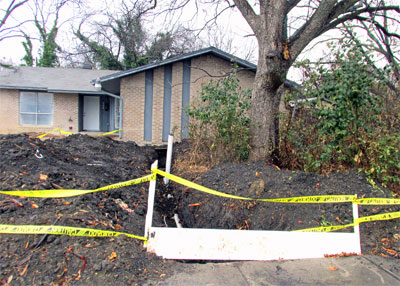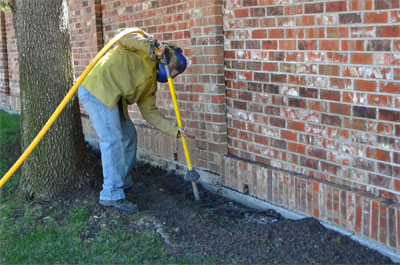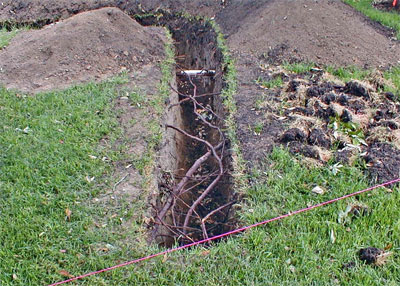Texas Tree Tips: February 2014

The trenching required to replace a sewer line can damage a tree’s roots and threaten the health and stability of the tree. Photo by Steve Houser.
by Steve Houser
Trenching Near Trees
“The trench for my replacement sewer line was only a few feet away from the trunk of my tree. Is that a problem?”
I try hard to hold back my true thoughts in answer to this common question, when I really want to ask, “How much do you need your toes or feet?”
It was once quite common to hear someone say that the root system of a tree is a mirror image of the above-ground portions. While this may be true when trees are small saplings, it is not true as they age. Have you ever tried to pull up a small volunteer pecan in your flowerbeds by the roots? If so, you likely gave up, switched to a shovel, and then changed to a backhoe — or dynamite. With saplings, the taproot and sinker roots can grow deep as a survival method to make it through the early years. As trees get larger, lateral-growing roots offer greater stability to the above-ground portions of the tree. They replace the tap and sinker roots. (When you are standing only on your toes, you are not as stable as standing with both feet on the ground.) As the outward-growing roots expand in diameter, they tend to eliminate the importance of the deeper roots, especially in heavier clay soils with adequate moisture and nutrients.
Most mature trees’ roots are in the top 4 to 6 feet of the soil, with the absorbing roots (the ones that do all the ongoing work) in the top 12 inches of the soil. The root system grows outward up to 3 to 4 times the spread of the limbs or canopy, with the roots inside the canopy edge being critical roots.
Anytime digging infringes on the critical roots, there is potential to affect the future health and structural integrity of the root system. Pathogens have the opportunity to enter the tree through the open wounds because the tree’s natural defenses are affected. The closer and deeper you dig near the trunk, the greater the potential impact in the future. Digging a trench near the trunk from one side of the canopy to the other could remove up to 45 per cent of the roots, depending on the depth. The result is the potential loss of the tree, or foliage dieback on at least one side of the crown. Damage of this scale most commonly occurs with sewer line replacements where trenching is often 5 to 6 feet deep.

Pneumatic digging allows trenching through a tree’s critical root zone without severing vital roots. Photo by Bill Seaman.
Any necessary trenching inside the critical root area, or zone, for installing irrigation pipes, gas lines, or electrical conduit requires careful planning to avoid damaging trees. The absorbing roots, as well as larger roots near the base, are shallow and easily damaged. One helpful hint: try to avoid trenching across outward-growing roots, and trench in the direction they are growing when possible. Also, have the location of all underground utilities confirmed before you dig.
If you must dig a deep trench near a tree, consider the option of boring under the roots. Larger utility lines of various types can often be placed at 6 feet deep in the soil by boring to avoid existing roots. Boring can be expensive, but preserving the health and structural integrity of valuable trees can be well worth it.

Using compressed air as a “shovel” preserves lateral roots and allows for irrigation lines and other utilities to be installed under spreading root systems. Photo by Bill Seaman.
Another option introduced a number of years ago uses high-pressure air to safely remove soil around tree roots (pneumatic digging). For shallow trenches, this tool is ideal, providing a method for a pipe or electrical line to be installed with minimal impact to the tree.
Roots supply nutrients for our trees, and trees tend to be very irritated when they are on a forced diet!
